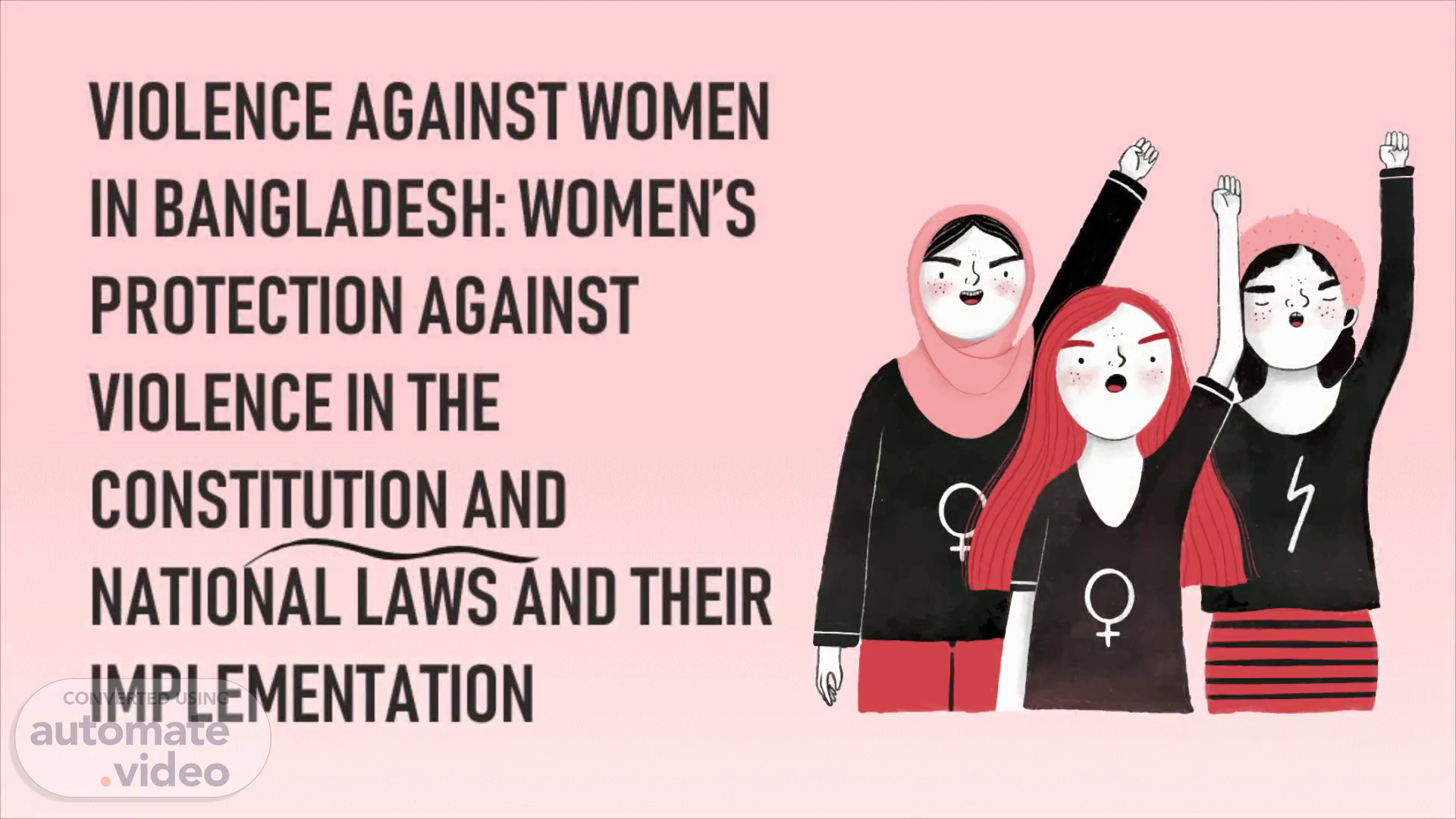
VIOLENCE AGAINST WOMEN IN BANGLADESH: WOMEN'S PROTECTION AGAINST VIOLENCE IN THE CONSTITUTION AND NATIONAL LAWS AND THEIR IMPLEMENTATION
Scene 1 (0s)
VIOLENCE AGAINST WOMEN IN BANGLADESH: WOMEN’S PROTECTION AGAINST VIOLENCE IN THE CONSTITUTION AND NATIONAL LAWS AND THEIR IMPLEMENTATION.
Scene 2 (10s)
PRESENTED BY : NAFIS AL SADIK ID: 18209008 COURSE: LAW345.
Scene 3 (18s)
1.Definition of violence against women. 2. Forms of violence against women in Bangladesh. 3. Protection of violence against women in the constitution. 4. Protection of violence against women in the national laws 5.Implementation of the constitutional provision. 6.Implementation of the national laws. 7. Challenges and obstruction for proper implementation. 8.Recommendation.
Scene 4 (39s)
Violence against women is defined by United Nations Commission of the Status of Women which says that any act done with an intention which results in or likely to result in psychological, physical or sexual harm or which causes sufferings to women..
Scene 5 (57s)
In Bangladesh the scenario of violence against women is noteworthy. The condition is serious as much as any deadly diseases which causes deaths of women. Forms of violence that are prevalent in Bangladesh are: Domestic violence Sexual violence Rape Sexual harassment Trafficking Early marriage Acid attacks.
Scene 6 (1m 16s)
The Constitution of Bangladesh protects and upholds the rights of the women against gender violence in different aspects. Article 11 guaranteed fundamental human rights and freedoms and respect for the dignity of the human beings. Article 13 provides that people shall own or control the instruments and means of production and distribution; which also ensures private ownership of property by women. Article 14 declares that it shall be a fundamental responsibility of the State to emancipate the toiling masses, the peasants and workers, and backward sections of the people from all forms of exploitation. Article 15 states that State accepts a fundamental responsibility towards raising the standard of living of the people, it specifically undertakes responsibility for providing social security to inter alia, widows..
Scene 7 (1m 51s)
Article 19 promulgates equality of opportunity and participation of women in all sphere of national life.. Article 27 declares all citizens are equal before the law and are entitled to equal protection of law. Article 28 enumerates that the State shall not discriminate against any citizen on the grounds of religion, race, caste, sex or place of birth. Women shall have equal rights with men in all fields of the State. Article 29 ensures quality of opportunity in public employment for all citizens Article 42 guarantees that every citizen shall have the right to acquire, hold, transfer or otherwise dispose of property Article 65 provides that women are free to contest election from any constituency and the parliament will reserve fifty seats exclusively for the women.
Scene 8 (2m 27s)
Different national legislations have been enacted to address the issues related to the violence against women and has specifically mentioned different legal remedies to the victim. The observations of different legislations addressing the issue are as follows: * The Penal Code, 1860 * The Prevention and Suppression of Human Trafficking Act, 2012 * The Women and Children Repression Prevention (Amendment) Act, 2020 * Dowry Prohibition Act, 2018 * Domestic Violence ( Prevention and Protection) Act, 2010 * Child Marriage Restraint Act, 2017 * The Acid Crime Prevention Act, 2002 * Muslim Law * Legal Aid Service Act, 2000 * Labor Act, 2006.
Scene 9 (2m 56s)
Initiated women development related policy. Many national legislation have been enacted inline with the constitution to stop specific violence against women. Women’s representation in local administrative institution has been amended. Number of reserved seats in the parliament has been increased. Various national plans and policy has been initiated to reduce discrimination as well as to increase participation in all aspects of public life..
Scene 10 (3m 17s)
Poor citizens’ got access to justice and enforcement of rights for women, children, and other disadvantaged groups of people. Special tribunals/speedy tribunals have been setup in every district for summery and exclusive trial. The National Acid Control Council Fund and Rehabilitation Centre has been established for giving victims treatment and legal aid to the victim of acid crimes. Maternity leave, proper wage, working environment of women has been developed. Anti-Human Trafficking Offence Tribunal has been established with a view to an speedy trial which has power to conclude the trial within 180 working days from the date of charge framing..
Scene 11 (3m 47s)
the Child Marriage Restraint Act, 2017(Amended version of the Child Marriage Restraint Amendment Act, 1984) which has increased the minimum age of marriage for men and women 21 and 18 years instead of 18 and 16 years respectively. The government has taken cognizance of the fact that dowry is a serious social malady that needs to be tackled with legislation..
Scene 12 (4m 8s)
Socio demographic factors Family factors Traditional and cultural practices perpetuating violence against women Socio-cultural factors disfavoring women Modernization Judiciary and law enforcement machinery Decline in moral and religious values.
Scene 13 (4m 23s)
Control on media Law enforcement Legislation Code of conduct Education and employment Moral and religious values Women’s representation should be ensured in different decision-making bodies..
Scene 14 (4m 38s)
—Ban Ki-Moon. “ There is one universal truth, applicable to all countries, cultures and communities: violence against women is never acceptable, never excusable, never tolerable .”.
Scene 15 (4m 51s)
THANK YOU.